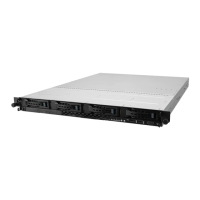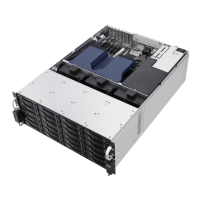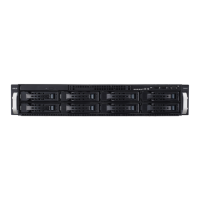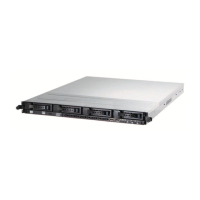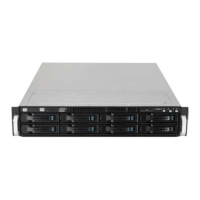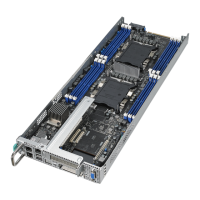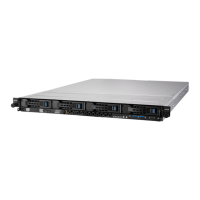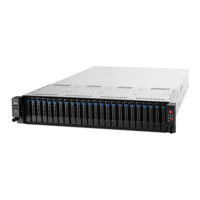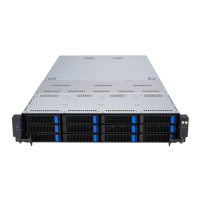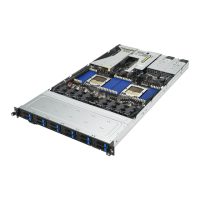Do you have a question about the Asus RS500A-E10 Series and is the answer not in the manual?
Lists all items included in the system package for the RS500A-E10 series.
Details the location and format of the product's 12-character serial number.
Provides detailed technical specifications for RS500A-E10-PS4, RS500A-E10-RS4, RS500A-E10-RS12U models.
Describes the components and layout of the server's front panel.
Details the connectors and components on the server's rear panel.
Illustrates and lists the main internal components of the server.
Explains the status and function of various LEDs on the server's front panel.
Instructions for removing and reattaching the server's chassis cover.
Information about the CPU socket and installation process for AMD EPYC processors.
Details DDR4 DIMM sockets and memory configuration options.
Procedures for installing 3.5" and 2.5" hot-swap SATA/SAS storage devices.
Guides for installing expansion cards, PIKE II, NVMe, M.2, and Mezzanine cards.
Identifies standard motherboard cable connections and their locations.
Explains the cabling for SATA/SAS storage devices and backplanes.
Instructions for replacing or installing optional components like fans and drives.
Steps for installing the tool-less friction rail kit into a server rack.
Provides dimensional drawings and measurements for the rail kit.
Diagram illustrating the location of motherboard components and connectors.
Explains the function and configuration of various motherboard jumpers.
Describes the purpose and status indications of onboard LEDs.
Details the various internal connectors on the motherboard.
Information on utilities for BIOS management and updating.
Guide to navigating and using the BIOS setup utility interface.
Overview of the BIOS Main menu for system information and basic settings.
Configuration options for CPU, PCI, USB, and other system devices.
Settings related to the motherboard's chipset configuration.
Options for setting passwords, Secure Boot, and system mode.
Configuration of system boot options and device priorities.
Access to special functions like IPMI hardware monitor and EZ Flash.
Options for saving BIOS changes, discarding, and exiting setup.
Detailed configuration options for AMD CPU and system features.
Settings for managing and viewing system event logs.
Configuration and status of server management features.
Instructions on using the bundled support DVD for drivers and utilities.
Visual representation of the motherboard's internal architecture and connections.
Compliance statements and regulatory information from FCC, ISED, REACH, etc.
Contact details for ASUS technical support and service centers globally.
Lists all items included in the system package for the RS500A-E10 series.
Details the location and format of the product's 12-character serial number.
Provides detailed technical specifications for RS500A-E10-PS4, RS500A-E10-RS4, RS500A-E10-RS12U models.
Describes the components and layout of the server's front panel.
Details the connectors and components on the server's rear panel.
Illustrates and lists the main internal components of the server.
Explains the status and function of various LEDs on the server's front panel.
Instructions for removing and reattaching the server's chassis cover.
Information about the CPU socket and installation process for AMD EPYC processors.
Details DDR4 DIMM sockets and memory configuration options.
Procedures for installing 3.5" and 2.5" hot-swap SATA/SAS storage devices.
Guides for installing expansion cards, PIKE II, NVMe, M.2, and Mezzanine cards.
Identifies standard motherboard cable connections and their locations.
Explains the cabling for SATA/SAS storage devices and backplanes.
Instructions for replacing or installing optional components like fans and drives.
Steps for installing the tool-less friction rail kit into a server rack.
Provides dimensional drawings and measurements for the rail kit.
Diagram illustrating the location of motherboard components and connectors.
Explains the function and configuration of various motherboard jumpers.
Describes the purpose and status indications of onboard LEDs.
Details the various internal connectors on the motherboard.
Information on utilities for BIOS management and updating.
Guide to navigating and using the BIOS setup utility interface.
Overview of the BIOS Main menu for system information and basic settings.
Configuration options for CPU, PCI, USB, and other system devices.
Settings related to the motherboard's chipset configuration.
Options for setting passwords, Secure Boot, and system mode.
Configuration of system boot options and device priorities.
Access to special functions like IPMI hardware monitor and EZ Flash.
Options for saving BIOS changes, discarding, and exiting setup.
Detailed configuration options for AMD CPU and system features.
Settings for managing and viewing system event logs.
Configuration and status of server management features.
Instructions on using the bundled support DVD for drivers and utilities.
Visual representation of the motherboard's internal architecture and connections.
Compliance statements and regulatory information from FCC, ISED, REACH, etc.
Contact details for ASUS technical support and service centers globally.
| Storage | 8 x 2.5" Hot-swap Storage Bays |
|---|---|
| SATA | SATA 6Gb/s |
| Networking | Dual-port Gigabit Ethernet (Intel I350-AM2) |
| Operating System Support | Windows Server, Linux |
| Form Factor | 1U Rackmount |
| M.2 | 1 x M.2 slot (PCIe Gen3 x4, up to 22110) |
